Daihatsu Terios
| Daihatsu Terios | |
|---|---|
 2018 Daihatsu Terios Custom (F800RG, Indonesia) | |
| Overview | |
| Manufacturer | Daihatsu |
| Production | 1997–present |
| Body and chassis | |
| Class | |
| Body style | 5-door wagon |
| Chronology | |
| Predecessor | Daihatsu Rocky |
The Daihatsu Terios (Japanese: ダイハツ テリオス Daihatsu Teriosu) is a mini SUV, first released in 1997 by the Japanese car manufacturer Daihatsu.
The "Terios" name is originated from the Old Greek word, which is roughly translated to "making dreams come true".[1]
First generation (J100; 1997–2006)
| First generation (J100) | |
|---|---|
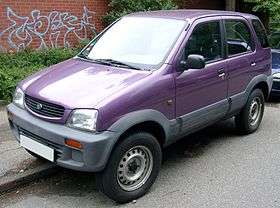 | |
| Overview | |
| Also called |
Daihatsu Taruna/Daihatsu Taruna OXXY (Indonesia) Luis 4U Green (Germany) Perodua Kembara (Malaysia) Premier Rio (India) Toyota Cami (Japan) Zotye 2008/5008 (China) Huali Dario Terios (China) |
| Production |
|
| Body and chassis | |
| Layout |
Front-engine, rear-wheel-drive Front-engine, four-wheel-drive |
| Related | Daihatsu Taruna |
| Powertrain | |
| Engine |
659 cc EF-DEM/EF-DET turbo I3 1.3 L HC-EJ SOHC I4 1.3 L K3-VE DVVT DOHC I4 |
| Transmission |
5-speed manual 4-speed automatic |

The first generation was available as a five-door estate, and the smaller kei car model called the Terios Kid, which was only released in Japan (see Japanese-language article Terios Kid). Model codes for the first generation were J100, J102, and J122. The Terios Kid arrived in October 1998 and continued to be built six years after the original Terios had been replaced.
In 2000, Daihatsu gave the Terios a mild facelift both in the exterior and interior of the vehicle. A new chrome grille replaced the black plastic grille. The high-grade model gained electric front windows, central locking, rear seat head restraints, alloy wheels, roof rails and a roof-mounted rear spoiler. Mechanically, the 1.3-litre SOHC four-cylinder engine fitted to the previous model had been replaced by the new 1.3-litre DOHC four-cylinder engine. Power was also increased by 3 kW (4 hp). A sport version of the K3-VET engine was produced in Japan.
In Australia, a limited edition sports series was introduced in 2001 with only 200 units being available. The vehicle had body colour matching bumpers, different from the two-tone bumper colour on the standard model. Rear spoiler and sunroof became standard. The interior was updated with metallic paint finish on the centre console and dashboard.
This was the first Daihatsu to be assembled in Venezuela, where production began in November 2001.[2]
Sales
By the end of 2002, Daihatsu sold 33,000 Terios and 97,000 Terios Kid.[3]
Versions
- Terios (first generation)
- J100G 1997-1999 "HC-EJ" SOHC 1295 cc engine 89 PS (65 kW; 88 hp) 4WD
- J102G 2000-2004 4WD
- engine "K3-VE" DOHC 1297 cc engine 92 PS (68 kW; 91 hp)
- engine "K3-VET" DOHC 1297 cc Turbo engine 140 PS (103 kW; 138 hp)
- J122G 2000-2004 2WD type ( K3-VE / K3-VET )
- Terios Kid (Kei model, available in the Japanese domestic market until May 2012)
- J111G ( EF-DEM ) 1998-2005 Light pressure turbo 659 cc 4WD 60 PS (44 kW; 59 hp)
- J111G ( EF-DET ) 1998-2012 Inter cooler turbo 659 cc 4WD 64 PS (47 kW; 63 hp)
- J131G ( EF-DEM ) 1998-2005 Light pressure turbo 659 cc 2WD 60 PS (44 kW; 59 hp)
- J131G ( EF-DET ) 1998-2012 Inter cooler turbo 659 cc 2WD 64 PS (47 kW; 63 hp)
- Terios Lucia (limited edition)
- J111G / J131G for 2002-2003 only; variation of Terios Kid (without spare tire)
Markets
Japan
The first-generation Daihatsu Terios is also known as the Toyota Cami (Japanese: トヨタ キャミ Toyota Kyami) in Japan.
Malaysia
In Malaysia, the car is locally assembled as the Perodua Kembara. It was unveiled in August 1998. In June 2003, the Perodua Kembara was updated with DVVT engines. In July 2004, the Perodua Kembara CT Elegance was unveiled and came with ABS, front dual airbags, leather seats, different designed alloy rim, flat type side step and cubic printing cluster. It was priced at RM59,988 and only available in one color: Klasik Gold.[4]
India
In India, there is a Terios-derived vehicle known as the Premier RiO from Premier Automobiles Limited, which is a re-badged Zotye Nomad I. It is powered by a Peugeot diesel and petrol engine, and since 2012 has a Fiat diesel option.
China
In China, it is known by two ways: one of them as under the badge as Zotye 2008 and 5008 propelled with a 1.5-litre engine provided by Mitsubishi (first series body); as an unauthorized copy of the car, which caused some controversy, and the FAW badged it as the Huali Terios or Dario.[5][6] Since 2009, Daihatsu withdrew from the China market due to bad performance, and sold the tooling and rights of this car to First Auto Works (FAW), who has been their partner in China. The new name now is the FAW (or YiQi) M80 SenYa (森雅). It is based on the Daihatsu Xenia/Toyota Avanza. Two versions 1.3L (K3) and 1.5L (3SZ) are sold, with either five or seven seats. Both engines are imported Toyota DVVT engines. Production for the Zotye 2008 ran from 2005 to 2010 while the 5008 was produced from 2008 to 2013.
Indonesia
In Indonesia, a version of the Terios is known as the Daihatsu Taruna (Japanese: ダイハツ・タルナ Daihatsu Taruna), with a longer rear-based body capable of seating seven people. The Taruna was launched in 1999 with a different fascia and a 1589 cc HD-C petrol engine. The engine was later replaced with a 1498 cc HE-E petrol engine with electronic fuel injection in 2001. The name Taruna translates roughly as "young knight" or "cadet" in Indonesian. It is available with standard CL and FL trims; deluxe CX and FX trims; and sporty CSX and FGX trims. There are also CSR and FGZ trim level, which are similar to CSX and FGX, with a 1589 cc HD-E petrol engine with electronic fuel injection.
A more "stylish" version, the Daihatsu Taruna OXXY, was launched in March 2005.[7]
Gallery
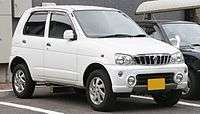 Daihatsu Terios Kid (front) (Japan)
Daihatsu Terios Kid (front) (Japan)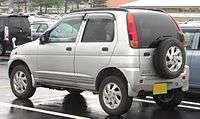 Daihatsu Terios Kid (rear) (Japan)
Daihatsu Terios Kid (rear) (Japan)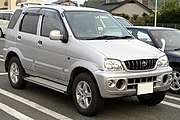 Toyota Cami (Japan)
Toyota Cami (Japan) Daihatsu Taruna (Indonesia)
Daihatsu Taruna (Indonesia)- Premier RiO (India)
%2C_Serdang.jpg) Perodua Kembara (Malaysia)
Perodua Kembara (Malaysia) Zotye 2008 (China)
Zotye 2008 (China)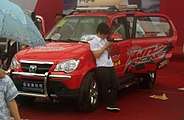 Zotye 5008 (China)
Zotye 5008 (China)
Second generation (J200/F700; 2006–2017)
| Second generation (J200/F700) | |
|---|---|
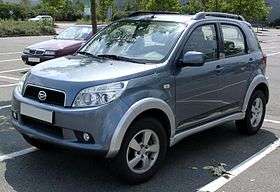 | |
| Overview | |
| Also called |
Daihatsu Be‣go (Japan) Toyota Rush Daihatsu Terios Eco (Turkey) Daihatsu Terios Wild/Advantage (Chile; SWB/LWB) Daihatsu Grand Terios (Egypt; LWB) Perodua Nautica (Malaysia) |
| Production |
2006–2016 (Japanese market) 2006–2017 (Indonesia) 2006–2018 (International) |
| Layout |
Front-engine, rear-wheel-drive Front-engine, four-wheel-drive |
| Powertrain | |
| Engine | 1.5 L 3SZ-VE I4 |
| Transmission | |
| Dimensions | |
| Wheelbase | 2,580 mm (101.6 in) |
| Length |
4,095 mm (161.2 in) (SWB) 4,425 mm (174.2 in) (LWB) |
| Width | 1,695 mm (66.7 in) |
| Height |
1,690 mm (66.5 in) (SWB) 1,745 mm (68.7 in) (LWB) |
| Curb weight |
1,170 kg (2,579 lb) (SWB) 1,210 kg (2,668 lb) (LWB) |
| Chronology | |
| Successor | Toyota C-HR (Japan) |
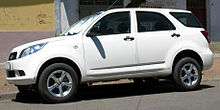
In European, South American and most other Asian markets, the new model is sold under the name Terios. Daihatsu designed and manufacture the Terios and also supplies the vehicle to Toyota under a consigned/OEM manufacturing agreement.[8]
The second generation known as Daihatsu D-Compact 4x4 Concept made an appearance in November 2005 at the Tokyo Motor Show before being named the new Daihatsu Terios, which went into production in January 2006. Model codes are J200, J210, and J211 for 5-seater version; model codes F700 and F710 for 7-seater version.
The second generation of the Terios is also wider, nearly 1700 mm, compared to the first generation which is less than 1500 mm. The 7-seater version has an increased exterior length to 4425 mm and height of 1745 mm. There are two wheelbase: Short (5-seater only) and Long (5-seater and 7-seater).
Markets
Japan
For the Japanese market, the first generation Terios was succeeded by the Daihatsu Be‣go (Japanese: ダイハツ ビーゴ Daihatsu Bīgo) and the Toyota Rush (Japanese: トヨタ ラッシュ Toyota Rasshu). The Daihatsu Be‣go and the Toyota Rush was discontinued in the Japanese market in March 2016 without a direct successor model, but Toyota in Japan has released the Toyota C-HR in December 2016 as the actual successor to the Toyota Rush.
Both use 1.3-litre or 1.5-litre engine. Only the 1.5-litre version is available with both two- or four-wheel drive.
The Terios features a permanent 4WD system via lockable central differential. However, it lacks low ratio gears.
A minor facelift of the both the Daihatsu Be-Go and the Toyota Rush was unveiled on 13 November 2008 in Japan. The minor facelift brought new front bumper, new tail lamps, new alloy wheel design for the G trim level and a 5% improvement for fuel economy for the 2WD automatic model.[9]
Indonesia
In December 2006, Toyota and Daihatsu launched the first generation Rush and second generation Terios in Indonesia. Both cars were sold in long wheelbase configuration. However, the car only comes in rear-wheel-drive layout.[10] The Daihatsu Terios and Toyota Rush are available only with the long wheelbase in Indonesia. The difference between Rush and Terios: Rush is designed for five people only, and Terios is designed for seven people, so the Rush lacks third row seating (although third-row seat is available as a dealer option). Also both cars have different rim, with seven bespoked wheel from JDM version of Toyota Rush installed on Daihatsu Terios and five-bespoked wheel from European market Daihatsu Terios installed on Toyota Rush.
In Indonesia, the second generation Daihatsu Terios came with three trim levels: X, X Extra, R and R Adventure. X and X Extra have almost spotless unsimilarities apart from parking sensor, wheel hub, and automatic transmission. Whilst Daihatsu Terios R have a striking differences even from the previous versions and facelifts, such as body kit design (R Adventure) and wheel arches, brand new bespoked alloy wheels, spoiler as standard (previous one was optional) and satnav with DVD player double din stereo, rear parking camera and HDMI input. The first generation Toyota Rush initially came with two trim levels: G and S. The S trim was later replaced by the TRD Sportivo variant in 2013.
In March 2015, the facelifted Daihatsu Terios and Toyota Rush was unveiled. The facelift models brought new projector headlights with LED positioning lights, a wider grille with a chrome lower bar, a full-width air intake for the lower bumper and a blacked-out center piece. For the interior, both Daihatsu Terios and Toyota Rush received new steering wheel design, a redesigned instrument cluster, new seat upholstery, reshaped second-row headrests and double-DIN touchscreen DVD head units on higher trim levels. The trim piece is finished in gloss black for the Daihatsu Terios and silver for the Toyota Rush.[11]
In February 2016, the TRD Sportivo Ultimo variant of the Toyota Rush was launched, and the TRD Sportivo 7 variant was updated.[12]
Malaysia
In Malaysia, the second generation Daihastu Terios is available as the Toyota Rush (2008 to 2017) and Perodua Nautica (2008 - 2009).
Toyota Rush
The Toyota Rush was launched in Malaysia on January 2008 with two variants: 1.5G (M/T & A/T) and 1.5S (A/T only). The Toyota Rush in Malaysia is the long wheelbase 7-seater version.[13]
For 2011, Toyota updated the Toyota Rush in Malaysia again offering the same two variants: 1.5G (M/T & A/T) and 1.5S (A/T only) with updates.[14]
In April 2015, Toyota introduced a facelift Toyota Rush, very similar to the facelifted Daihatsu Terios and Toyota Rush in Indonesia. Exterior changes included redesigned front bumper, radiator grille and bonnet. The bumper is finished in a two-tone effect and the grill finished with faux carbon-fibre. Elsewhere, there’s a new integrated chrome lining highlight running across the headlamp and radiator grille, restyled rear lamps featuring combination LEDs with smoked lenses. Again the same two variants were available: 1.5G (M/T & A/T) and 1.5S (A/T only). The 1.5S has in additional equipment including fog lamps, chrome covers for the wing mirrors, and leather steering wheel and gear knob.[15]
Perodua Nautica
Perodua, Daihatsu's local partner in Malaysia launched a short wheelbase version of the Daihatsu Terios. Sold as the Perodua Nautica, it was launched in Malaysia in May 2008. This was fully imported from Japan, except for the front grille, front bumper and rear bumper which are manufactured and fitted in Malaysia. It has a 1.5-litre DVVT engine, full-time 4WD, projector headlamps, a 5-seater with dark interior. The price tag of the Perodua Nautica is not much different from the long-wheelbase Toyota Rush. It comes with only two colour choices: (Medallion Grey and Majestic Black) and comes in automatic transmission only. The Nautica was quietly discontinued in 2009, slightly less than a year after its launch. Only a mere total of 489 units were ever sold.[16] The reason for the discontinuation was because as a national car company focused on local manufacturing, Perodua was unable to obtain sufficient necessary Approved Permits for vehicle importation, as the Nautica was imported in CBU form from Japan.
Gallery
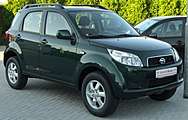 Daihatsu Terios (short wheelbase) (pre-facelift, Germany)
Daihatsu Terios (short wheelbase) (pre-facelift, Germany)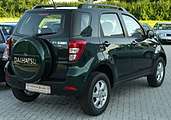 Daihatsu Terios (short wheelbase) (pre-facelift, Germany)
Daihatsu Terios (short wheelbase) (pre-facelift, Germany)- Daihatsu Terios (short wheelbase) (2009 facelift, Germany)
- Daihatsu Terios (short wheelbase) (2009 facelift, Germany)
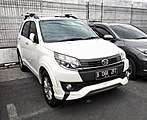 Daihatsu Terios 1.5 R (long wheelbase) (F700RG; 2015 facelift, Indonesia)
Daihatsu Terios 1.5 R (long wheelbase) (F700RG; 2015 facelift, Indonesia) 2006 Daihatsu Be‣go interior (Japan)
2006 Daihatsu Be‣go interior (Japan)
Third generation (F800; 2017–present)
| Third generation (F800) | |
|---|---|
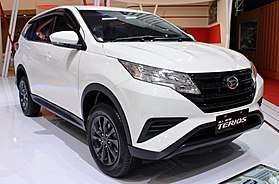 2018 Daihatsu Terios 1.5 X Deluxe (F800RG, Indonesia) | |
| Overview | |
| Also called | Toyota Rush |
| Production | 2017–present |
| Assembly | Indonesia: Sunter, North Jakarta (Astra Daihatsu Motor - Sunter Assembly Plant) |
| Designer | Eiji Fujibayashi (2015) |
| Body and chassis | |
| Layout | Front-engine, rear-wheel-drive |
| Related | Toyota Avanza |
| Powertrain | |
| Engine | 1.5 L 2NR-VE I4 |
| Power output | 76 kW (102 hp; 103 PS) |
| Transmission | |
| Dimensions | |
| Wheelbase | 2,685 mm (105.7 in) |
| Length | 4,435 mm (174.6 in) |
| Width | 1,695 mm (66.7 in) |
| Height | 1,705 mm (67.1 in) |
| Curb weight | 1,270 kg (2,800 lb) |
The third generation Terios was unveiled in Indonesia on 23 November 2017, along with the second generation Rush.[17][18][19][20] It is now based on the Avanza/Xenia platform, which rides on an unibody chassis. Compared to their predecessors, the design of the car is now more streamlined. It is now features a rear liftgate rather than a side-opening rear door and no longer has the spare tire mounted on the rear door. Both cars are sold in long wheelbase version only. The short wheelbase version was discontinued.
Markets
Indonesia
The Indonesian market Terios/Rush went on sale on 3 January 2018 with their price starting at Rp 195,200,000 for Terios and Rp 239,900,000 for Rush, almost the same price but slightly lower than the previous generation, despite using more features.[21][22] Both cars are offered in 7-seater variant only.
The Rush is available in 2 variants:
- 1.5 G
- 1.5 TRD Sportivo
The Terios is available in 4 variants:
- 1.5 X
- 1.5 X Deluxe
- 1.5 R
- 1.5 R Deluxe
Both of them comes with LED headlamps and taillights, 16-inch alloy wheels, dual airbags, ABS and EBD, 2 DIN touchscreen audio system with six speakers and an air conditioning system with memory function as standard equipment. However, the Rush gains side and curtain airbag (six airbags in total), ESP, hill-start assist, emergency brake signal, engine start/stop button and 7 seat belt indicators as standard equipment on all variants. TRD Sportivo trim added body kit cladding, 17-inch alloy wheels, keyless entry, auto climate control air conditioning, leather-wrapped steering wheel, shift knob, dashboard and door trim, colored instrument panel and 8 speakers setup. The Terios doesn't have six airbags, and seat belt indicators, but it comes with 360-degree around view camera.
In August 2018, the Terios Custom variant was added.[23]
Philippines
The second generation Rush was released in the Philippines on 4 May 2018.[24][25][26] The Rush is offered in 3 variants; E (5-seater) M/T, E (5-seater) A/T, and G (7-seater) A/T.
Brunei
After the replacement of the first and second generation Terios (sold under Daihatsu badge), the second generation Rush was released in Brunei on 5 May 2018.[27] The car is available in mid or high grade model lineups, 4-speed automatic transmission and 7-seater variant only.
United Arab Emirates
The second generation Rush was released in UAE on 14 May 2018.[28][29] The car is available in 7-seater variant only.
South Africa
The second generation Rush was released in South Africa on 4 July 2018.[30] The car is available in 5-seater variant only. It is available as a 5-speed manual and 4-speed automatic.
Jamaica
The second generation Rush was released in Jamaica on 8 July 2018.[31] The car is available in 7-seater variant only.
Colombia
The second generation Rush was released in Colombia on 26 July 2018.[32][33][34] The car is available in 7-seater variant only.
Pakistan
The second generation Rush was unveiled in Pakistan on 31 August 2018. It went on sale on 10 September 2018. It is available in 3 variants and 7-seater option only.[35][36][37]
Malaysia
The second generation Rush will be released in Malaysia on 18 October 2018.[38] The car is available in 5-seater variant only. It is available as a 5-speed manual and 4-speed automatic.
Gallery
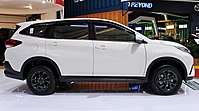 2018 Daihatsu Terios 1.5 X Deluxe (F800RG, Indonesia)
2018 Daihatsu Terios 1.5 X Deluxe (F800RG, Indonesia) 2018 Daihatsu Terios 1.5 X Deluxe (F800RG, Indonesia)
2018 Daihatsu Terios 1.5 X Deluxe (F800RG, Indonesia).jpg) 2018 Daihatsu Terios 1.5 R (F800RG, Indonesia)
2018 Daihatsu Terios 1.5 R (F800RG, Indonesia)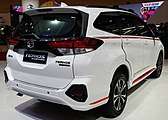 2018 Daihatsu Terios Custom (F800RG, Indonesia)
2018 Daihatsu Terios Custom (F800RG, Indonesia).jpg) 2018 Toyota Rush 1.5 TRD Sportivo (Indonesia)
2018 Toyota Rush 1.5 TRD Sportivo (Indonesia).jpg) 2018 Toyota Rush 1.5 TRD Sportivo interior (Indonesia)
2018 Toyota Rush 1.5 TRD Sportivo interior (Indonesia)
References
- ↑ https://jip.gridoto.com/read/05221072/wah-ternyata-ini-arti-nama-daihatsu-terios?page=all#!%2F
- ↑ "Annual Report 2002" (PDF). Osaka, Japan: Daihatsu Motor Co. March 2002. p. 14. Archived from the original (PDF) on 18 December 2010.
- ↑ "Terios to Be Produced in China Under New Technical Licence Agreement with FAW Huali (24 Jan 2003)" (Press release). Daihatsu. 24 January 2003. Retrieved 13 January 2018.
- ↑ "Perodua :: News & Events :: 2004". 16 April 2007. Archived from the original on 16 April 2007. Retrieved 3 September 2017.
- ↑ "FAW.com". FAW. Archived from the original on 14 January 2016.
- ↑ "活力小子:紧凑型SUV TERIOS 来了(多图)". Wood (in Chinese). Sohu.com. 4 October 2003. Archived from the original on 17 April 2004.
- ↑ "Peluncuran Taruna OXXY" [Launch of the Taruna OXXY]. Daihatsu Press Release (in Indonesian). PT. Astra Daihatsu Motor. 24 March 2005. Archived from the original on 26 August 2007.
- ↑ "Daihatsu 2010 Annual Report" (PDF).
- ↑ "2009 Toyota Rush Facelift unveiled in Japan". Paul Tan's Automotive News. 15 November 2008. Retrieved 28 July 2017.
- ↑ "PT Astra Daihatsu Motor Luncurkan Daihatsu Terios" [PT Astra Daihatsu Motor launches the Daihatsu Terios]. Daihatsu Press Release (in Indonesian). PT. Astra Daihatsu Motor. 14 December 2006. Archived from the original on 10 January 2007.
- ↑ "Toyota Rush, Daihatsu Terios facelift now in Indonesia". Paul Tan's Automotive News. 21 March 2015. Retrieved 28 July 2017.
- ↑ "Updated 2016 Toyota Rush 7 launched in Indonesia". Paul Tan's Automotive News. 29 February 2016. Retrieved 28 July 2017.
- ↑ "New 7-seater Toyota Rush SUV launched!". Paul Tan's Automotive News. 29 January 2008. Retrieved 28 July 2017.
- ↑ "Toyota Rush updated for 2011 with darker interior". Paul Tan's Automotive News. 10 December 2010. Retrieved 30 July 2017.
- ↑ "2015 Toyota Rush facelift introduced in Malaysia". Paul Tan's Automotive News. 24 April 2015. Retrieved 28 July 2017.
- ↑ "Malaysian Automotive Association Total Industry Volume".
- ↑ "All New Terios Meluncur, Begini Perubahannya". Kompas.com. 23 November 2017. Retrieved 23 November 2017.
- ↑ "Ini Dia Generasi Terbaru Toyota Rush". Kompas.com. 23 November 2017. Retrieved 23 November 2017.
- ↑ "New 2018 Toyota Rush SUV makes debut in Indonesia". Paul Tan's Automotive News. 23 November 2017. Retrieved 23 November 2017.
- ↑ "New 2018 Daihatsu Terios makes debut in Indonesia". Paul Tan's Automotive News. 23 November 2017. Retrieved 23 November 2017.
- ↑ "2018 Toyota Rush Indonesia pricing revealed – no increase despite higher specs, from RM72k-RM78k". Paul Tan's Automotive News. 3 January 2018. Retrieved 4 February 2018.
- ↑ "2018 Daihatsu Terios pricing announced in Indonesia – RM58k to RM74k, most variants cheaper than before". Paul Tan's Automotive News. 4 January 2018. Retrieved 4 February 2018.
- ↑ http://otodriver.com/article/view/giias-2018-daihatsu-terios-dapat-varian-baru-bodi-lebih-sporty/VmTOJ47chdTtLAdst8fSr-TcASdiLEELDOjNC4GHaXY
- ↑ "Toyota PH launches all-new Rush SUV". motioncars.inquirer.net.
- ↑ "2018 Toyota Rush launched in the Philippines - Indian Autos blog". 7 May 2018.
- ↑ "Toyota rolls out much-awaited Rush".
- ↑ "All-new Toyota Rush makes Brunei debut – Borneo Bulletin Online". 5 May 2018.
- ↑ "Toyota Rush launched at Dubai's Palazzo Versace – in pictures".
- ↑ "Al-Futtaim Toyota launches new compact SUV". www.tradearabia.com.
- ↑ https://www.wheels24.co.za/NewModels/toyota-debuts-stylish-rush-suv-heres-how-much-the-baby-fortuner-costs-in-sa-20180704
- ↑ http://jamaica-gleaner.com/article/auto/20180708/toyota-jamaica-expecting-drivers-rush-new-vehicle
- ↑ http://www.eluniversal.com.co/autos/toyota-lanza-en-cartagena-una-nueva-propuesta-rush-283728
- ↑ http://www.elcolombiano.com/tendencias/sin-prisa-e-ideal-para-terrenos-agrestes-DA9255849
- ↑ https://indianautosblog.com/2018/08/india-waits-toyota-rush-heads-colombia-312875
- ↑ https://www.thenews.com.pk/print/361717-imc-unveils-new-toyota-rush
- ↑ https://www.pakwheels.com/blog/toyota-rush-2018-3-variants/
- ↑ https://www.researchsnipers.com/toyota-rush-launched-in-pakistan-with-three-variants/
- ↑ https://paultan.org/2018/10/09/2018-toyota-rush-launching-in-malaysia-on-october-18/
External links
|
|
« previous — Daihatsu road vehicle timeline, 1990s–present | ||||||||||||||||||||||||||||||||||||
|---|---|---|---|---|---|---|---|---|---|---|---|---|---|---|---|---|---|---|---|---|---|---|---|---|---|---|---|---|---|---|---|---|---|---|---|---|
| Type | 1990s | 2000s | 2010s | |||||||||||||||||||||||||||||||||
| 0 | 1 | 2 | 3 | 4 | 5 | 6 | 7 | 8 | 9 | 0 | 1 | 2 | 3 | 4 | 5 | 6 | 7 | 8 | 9 | 0 | 1 | 2 | 3 | 4 | 5 | 6 | ||||||||||
| Kei car | Mira/Cuore | Mira/Cuore | Mira/Cuore | Mira/Cuore | Mira/Cuore/Charade | |||||||||||||||||||||||||||||||
| Naked | Esse | Mira e:S | ||||||||||||||||||||||||||||||||||
| Leeza | Mira Gino | Mira Gino/Trevis | Mira Cocoa | |||||||||||||||||||||||||||||||||
| Opti | Opti | Tanto Exe | ||||||||||||||||||||||||||||||||||
| Move | Move | Move | Move | Move | ||||||||||||||||||||||||||||||||
| MAX | Sonica | |||||||||||||||||||||||||||||||||||
| Tanto | Tanto | |||||||||||||||||||||||||||||||||||
| Wake | ||||||||||||||||||||||||||||||||||||
| Subcompact car | Mira Gino 1000 | Ayla | ||||||||||||||||||||||||||||||||||
| Charade | Charade | Ceria | Charade | |||||||||||||||||||||||||||||||||
| Storia/Sirion | Boon/Sirion | Boon/Sirion | Boon | |||||||||||||||||||||||||||||||||
| Compact car | Applause | |||||||||||||||||||||||||||||||||||
| Mid-size car | Altis | Altis | Altis | Altis | ||||||||||||||||||||||||||||||||
| Sports car | Leeza Spider | Copen | Copen | |||||||||||||||||||||||||||||||||
| Mini MPV | YRV | Coo/Materia | ||||||||||||||||||||||||||||||||||
| Boon Luminas | Sigra | |||||||||||||||||||||||||||||||||||
| Pyzar/Gran Move | Pyzar/Gran Move | Xenia | Xenia | |||||||||||||||||||||||||||||||||
| Mini SUV | Rocky/Feroza/Sportrak | Rocky/Feroza/Sportrak | ||||||||||||||||||||||||||||||||||
| Terios/Taruna | Be-go/Terios | |||||||||||||||||||||||||||||||||||
| Terios Kid | ||||||||||||||||||||||||||||||||||||
| Compact SUV | Rugger/Fourtrak/Taft | Rugger/Fourtrak | ||||||||||||||||||||||||||||||||||
| Kei truck/Microvan | Hijet | Hijet | Hijet | Hijet | ||||||||||||||||||||||||||||||||
| Midget II | ||||||||||||||||||||||||||||||||||||
| MUV/Light commercial vehicle | Delta Van | Delta Van | Zebra | |||||||||||||||||||||||||||||||||
| Delta | Delta | Delta | ||||||||||||||||||||||||||||||||||
| Atrai 7 | ||||||||||||||||||||||||||||||||||||
| Hijet Gran Cargo/Extol | Gran Max | |||||||||||||||||||||||||||||||||||
| Luxio | ||||||||||||||||||||||||||||||||||||
Perodua road vehicle timeline, 1994–present | |||||||||||||||||||||||||||||
|---|---|---|---|---|---|---|---|---|---|---|---|---|---|---|---|---|---|---|---|---|---|---|---|---|---|---|---|---|---|
| Type | 1990s | 2000s | 2010s | ||||||||||||||||||||||||||
| 4 | 5 | 6 | 7 | 8 | 9 | 0 | 1 | 2 | 3 | 4 | 5 | 6 | 7 | 8 | 9 | 0 | 1 | 2 | 3 | 4 | 5 | 6 | 7 | 8 | |||||
| Kei car | Kancil | ||||||||||||||||||||||||||||
| City car | Kelisa | Viva | Axia | ||||||||||||||||||||||||||
| Bezza | |||||||||||||||||||||||||||||
| Supermini | Myvi | Myvi | Myvi | ||||||||||||||||||||||||||
| Mini SUV | Kembara | Nautica | |||||||||||||||||||||||||||
| Mini MPV | Kenari | ||||||||||||||||||||||||||||
| Compact MPV | Alza | ||||||||||||||||||||||||||||
| Microvan | Rusa | ||||||||||||||||||||||||||||